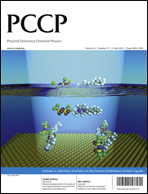Air–liquid interfaces of imidazolium-based [TF2N−] ionic liquids: insight from molecular dynamics simulations†
Abstract
We present molecular dynamics simulations of the air–liquid interface for three room temperature ionic liquids with a common anion: bis(trifluoromethylsulfonyl) imide ([Tf2N]), and imidazolium-based cations that differ in the alkyl tail length: 1-butyl-3-methylimidazolium ([C4mim]), 1-hexyl-3-methylimidazolium ([C6mim]), and 1-octyl-3-methylimidazolium ([C8mim]). The CHARMM type force field is used with the partial charges based on quantum calculations for isolated ion pairs. The total charge on cations and anions is around 0.9e and −0.9e, respectively, which somewhat mimics the anion to cation charge transfer and many-body effects. The surface tension at 300 K is computed using the mechanical route and its value slightly overpredicts experimental values. The air–liquid interface is analyzed using the intrinsic method of Identification of the Truly Interfacial Molecules. Structural and dynamic properties of the interfacial, sub-interfacial and central layers are determined. To describe the structure of the interface, we compute the surface roughness, number density and charge density profiles, and orientation ordering of the ions. We further determine the survival probability, normal and lateral self-diffusion coefficients, and re-orientation correlation functions to characterize the dynamics of the cations and anions in the layers. We found a significant enhancement of the cation density and preferential orientation ordering of both the cations and anions at the interface. Overall, the surface of the interfacial layer is smoother than the surface of the sub-interfacial layer and the roughness of both the interfacial and sub-interfacial layers increases with the increase of the length of the cation alkyl tail. Finally, the ions stay considerably longer in the interfacial layer than in the sub-interfacial layer and dynamics of exchange of the ions between the consecutive layers is related to the distinct diffusion and re-orientation dynamics behavior of the ions within the layers.
![Graphical abstract: Air–liquid interfaces of imidazolium-based [TF2N−] ionic liquids: insight from molecular dynamics simulations](/en/Image/Get?imageInfo.ImageType=GA&imageInfo.ImageIdentifier.ManuscriptID=C2CP23572B&imageInfo.ImageIdentifier.Year=2012)
- This article is part of the themed collection: Interfaces of Ionic Liquids

 Please wait while we load your content...
Please wait while we load your content...